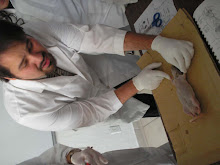Last Class, we started talking about the body...
We looked that for scientists, the body has many points of view, or "planes"
If we were to look it from the front, and we divide it "vertically" into 2, we would call it "Sagittal PLane" Left + Right
If we were to look it from one side, and we divide it "vertically" into 2, or parts would be "coronal plane "dorsal + ventral"
-dorsal stand for the "back" part, and "ventral" stand for the frontal part of our body
If we were to look it from the front, and we divide it "horzontally" into 2 we would call it "transverse plane" up + down

After that, we saw many scientific concepts for the location of parts of the body:
locations
distal: far from
closal: clase to
craneal: to the superior part, or "to the crane"
caudal: to the feet
movements
medial: any extremity going to the body's midline
lateral: away from midline
After this concepts and stuff, we started with the skeletal system B)

We have around 206 bones, and our skeletal system mainly divides into 2 parts.
Axial Skeleton + Appendicular skeleton... ;D
The axial skeleton is conformed by the craneum and the spine, ribs and sternum
The Appendicular skeleton is conformed by Limbs, gidles, and its waht sticks to the axial skeleton.
There are several arrangements or classifications in the bones, there are considered in 4 classes:
Long, Short, Flat, irregular and Sesamoid bones...
The first ones, long bones, are called like that because they are "Long" and one of their characteristics are that they are semi-flexed, to resist pressure. They are mainly find y legs, and arms.
The other ones, the short bones are a bit shorter, and they are mainly founded in foot structures and tarsals, structures of the hand.
Flat bones: Characterized because their "large" area and almost no thickness, for example ribs, sternum, and bones from the craneum...
Irregular bones: With no defined shape, and may function like the other 3 mentioned, for example vertebraes, scapula, heel bone, etc.
Sesamoid bones: This ones, are not officially considered, because of their size, they are like one "sesame seed" and many people have more than others, for example, athletes have more than normal people.


No hay comentarios:
Publicar un comentario